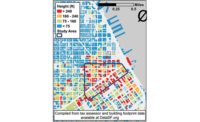In August 2005, the board of directors of the Louisiana Children’s Museum approved a modest $2-million plan to expand outreach for parents by remodeling 1,500 sq ft of the museum’s existing 30,000 sq ft of space. A few weeks later, Hurricane Katrina hit. The building, located in New Orleans’ Warehouse District, was flooded and closed for 10 months for repairs.
Initially, the staff and board weren’t sure the museum would survive, let alone expand. “We thought, as a small children’s museum, it wasn’t realistic that we could make a difference,” says Julia Bland, the museum’s CEO. But within months, leaders realized that the city—torn apart by Katrina—needed an even larger museum and the resources that it could provide to reach more children and parents.
The building will “advance the understanding of being a good steward and living in a more sustainable way.”
– Julia Bland, CEO, Louisiana Children’s Museum
Thirteen years later, that vision is coming to life with a 56,400-sq-ft museum sited on a lagoon and 8.5 acres of land in New Orleans’ 1,300-acre City Park. The museum will highlight the importance of investing in young children. Its south wing will be open to the public free of charge and offer spaces for resources such as health and early childhood learning that the museum had planned to incorporate in its existing space before the storm hit.
The $47.5-million project has come to fruition through a close working relationship between the museum and the community as well as architect Mithun, contractor Roy Anderson Corp., structural engineer Thornton Tomasetti and mechanical and electrical engineer ARUP, among others.
“We are working very closely with the architect,” says Steven Moore, project manager for Roy Anderson Corp. (RAC). “We’ve turned it into a partnership.”
The two-story building with two wings joined by a fritted glass hallway was designed to be both sustainable and resilient, Bland says. Nestled among 26 mature live oaks, the project is seeking LEED Silver certification. It features the first radiant-cooling system in the region and outdoor play spaces that include a floating classroom on a barge. The building and its exhibits will “advance the understanding of being a good steward and living in a more sustainable way,” Bland says.
The exhibit wing, among other things, will feature a 100-ft table model of the Mississippi River, a sound studio and a life-size chess board with squares that makes the sounds of the city.
Bogged down by several weeks of rain, major construction is set to be complete by the end of April. The opening is slated for late summer or early fall after Gyroscope Inc. installs the exhibits.
Integrated Spaces
To help create the building, its landscape and exhibits, the museum turned to Mithun, which partnered with local architect Waggonner & Ball. Richard Franko, a partner at Mithun who oversaw the design, says the layout of the building is unique in many ways.
“We use the whole experience, even how they move through the space,” he said in a recent tour of the site. As an example, Franko pointed to the bridge across the lagoon that provides one of the entrances to the museum. When visitors cross the water, they will walk through an interactive “sculptural fog environment” created by Japanese artist Fujiko Nakaya that will produce a foggy, misty or cloudy atmosphere, depending upon the weather. Another experiential feature is the 7,770-sq-ft, covered front porch that spans the front of the building and will feature Mardi Gras-like beads on the railing.
Franko says the design team was heavily influenced by the documentary “Katrina’s Children” about the impact of the storm on the city’s children. After seeing the film, he says, “We wanted to treat associations with water in a positive way.”
The site, which flooded up to about 4 ft during Katrina, is designed to hold up to 3 ft of water during future storms to keep nearby neighborhoods from being inundated. The building itself is raised 5 ft above ground and meets requirements of New Orleans’ building code for the hurricane-prone region.
Integration with the site is a key component of the project. As well as a large lawn, the landscape features 47,000 sq ft of outdoor exhibit space, including native Louisiana plantings and a play area with runnels placed around the oak trees.
The building is situated in a skewed “H” formation so as not to disturb the live oaks and offers views of the trees as visitors move through the museum. The trees are so important that RAC’s contract spells out penalties for any damage to them. In addition to installing 2,200 ft of fencing around the oaks, the company took out an insurance policy on the trees.
The trees, some with sprawling branches that reach the ground and entice children to play on the limbs, also inspired the building’s interiors, which will have small places for children to play amid the wide-open spaces, Franko says. Some of the more than 100 supporting columns are fitted with knife plates at the bottom that children can touch. RAC’s crews hand-welded each of the components on the “cruciform” columns. Twelve “kindows”—kid-size windows—jut from the exterior and allow children to climb into them.
Key Partnerships
Franko and Bland credit RAC for being receptive to the unusual design elements.
“They’ve been a really good partner,” Franko says of RAC. “They’ve been really resourceful in a lot of unique detailing. These aren’t easy details, but they want it to be right.”
One of the more difficult aspects was the skewed, gabled metal roof that runs continuous from outside to inside. The roof perforations required RAC to design a barrier at the roofline to keep it from pulling in hot air. Additionally, the roofline had to be constructed using compound slopes, angled two different ways.
“Their attitude was, ‘How do we fix this?’ says David Demsey, who was Waggonner & Ball’s architect on the job. “It’s a very complicated building, subtle in its complexity.”
The building’s slender-looking facade and its wide-open exhibit spaces, for instance, required complex steel joints. The concrete floor slab, up to 19 in. thick in places, acts as a diaphragm to resist the lateral loads. The slab sits on caps over 882 pilings driven 65 ft deep in the site’s mucky, gumbo soil. In all, RAC used 6,400 cu yd of concrete and 545 tons of steel to construct the museum.
One of the biggest challenges was dealing with the lagoon, says Moore, especially in building the porch, which sits over water. Crews constructed temporary dams to pump out about 7.5 ft of water so piles could be driven. RAC site superintendent Benjamin Herron called in the state’s fish and wildlife service to remove about 4,000 fish from the lagoon.
The concrete bridge across the lagoon was originally going to be built from the shore, but the crane and other heavy equipment sank in the muck, Herron says. As a result, a barge was used to construct the bridge. “Mother nature was not conducive,” he says. Water was a constant challenge. In one month alone, there were 22 days of rain at the site.
Taming the Elements
Heat was another element that required taming. Everything from the building envelope—with its 15,000 sq ft of glass curtain wall and 30,000 sq ft of fiber cement panels—to decorative fritting and heavy louvers shading the porch was designed to keep the building cool. The most innovative measure, however, was the use of a radiant-chilled slab in nearly a third of the building. The region’s heat and humidity have prevented similar systems from being used. But ARUP, which has installed radiant cooling in similarly humid and hot Singapore, knew how to counteract the climate, including separating the radiant-cooled section of the building from other sections using glass doors and walls.
While 13 years is a long time to bring a project to fruition, Bland says the delay worked in the museum’s favor because it gave collaborators and designers more time to engage the public through workshops, solicit children’s art, record city sounds and perfect the design so the museum could provide a true New Orleans experience.
“There are a million fingerprints from our community,” she says. “It will be fun and surprising everywhere you turn.”









Post a comment to this article
Report Abusive Comment